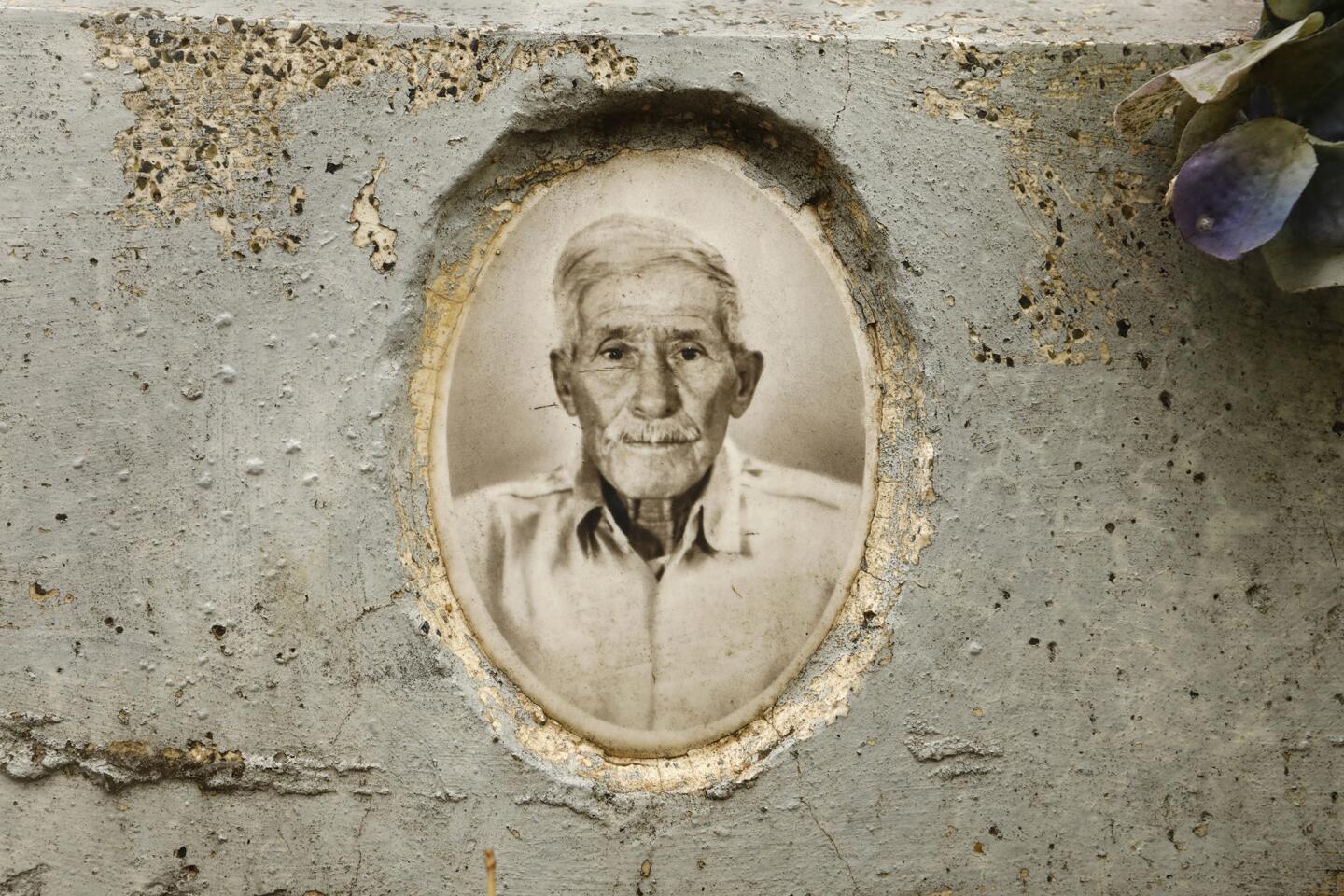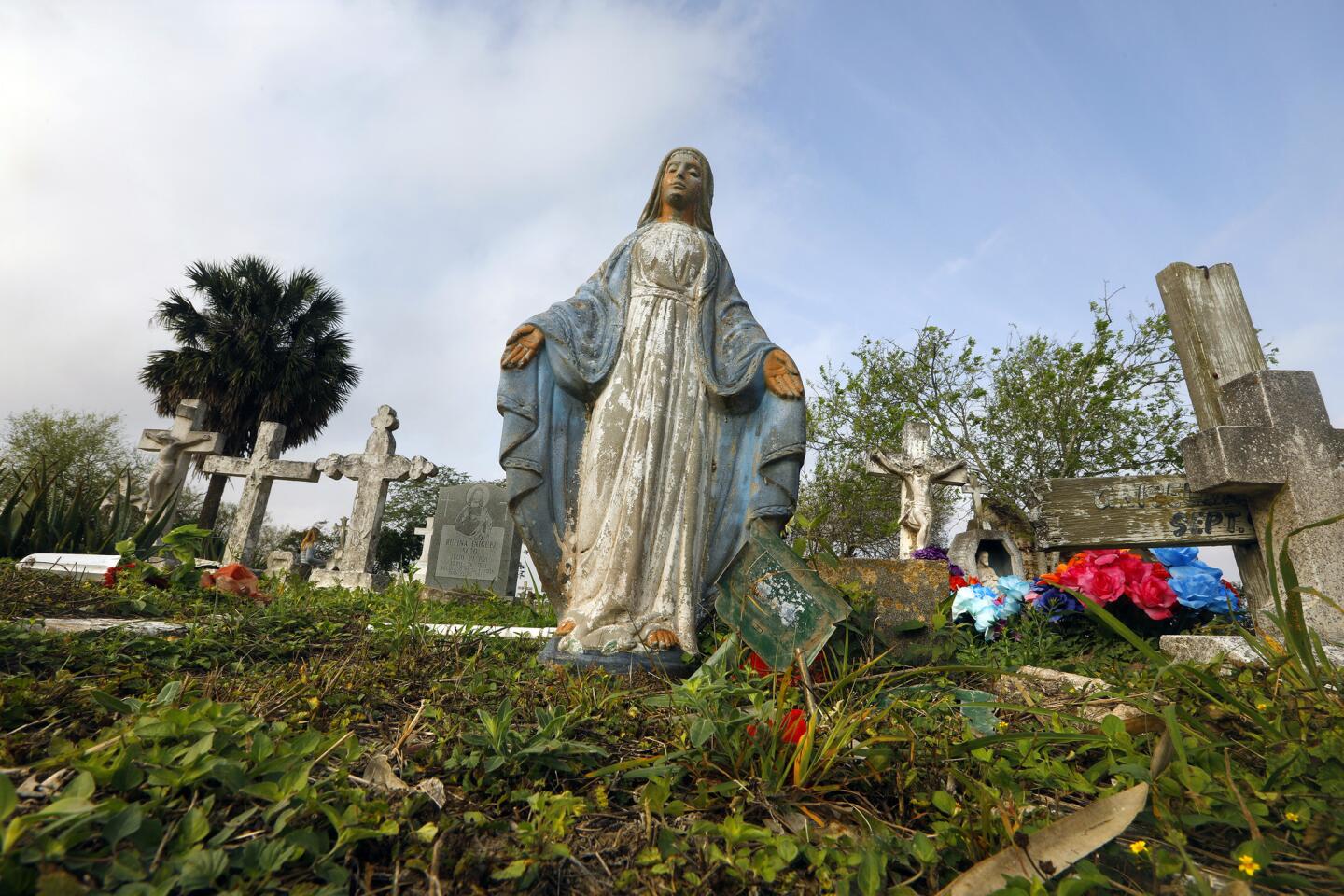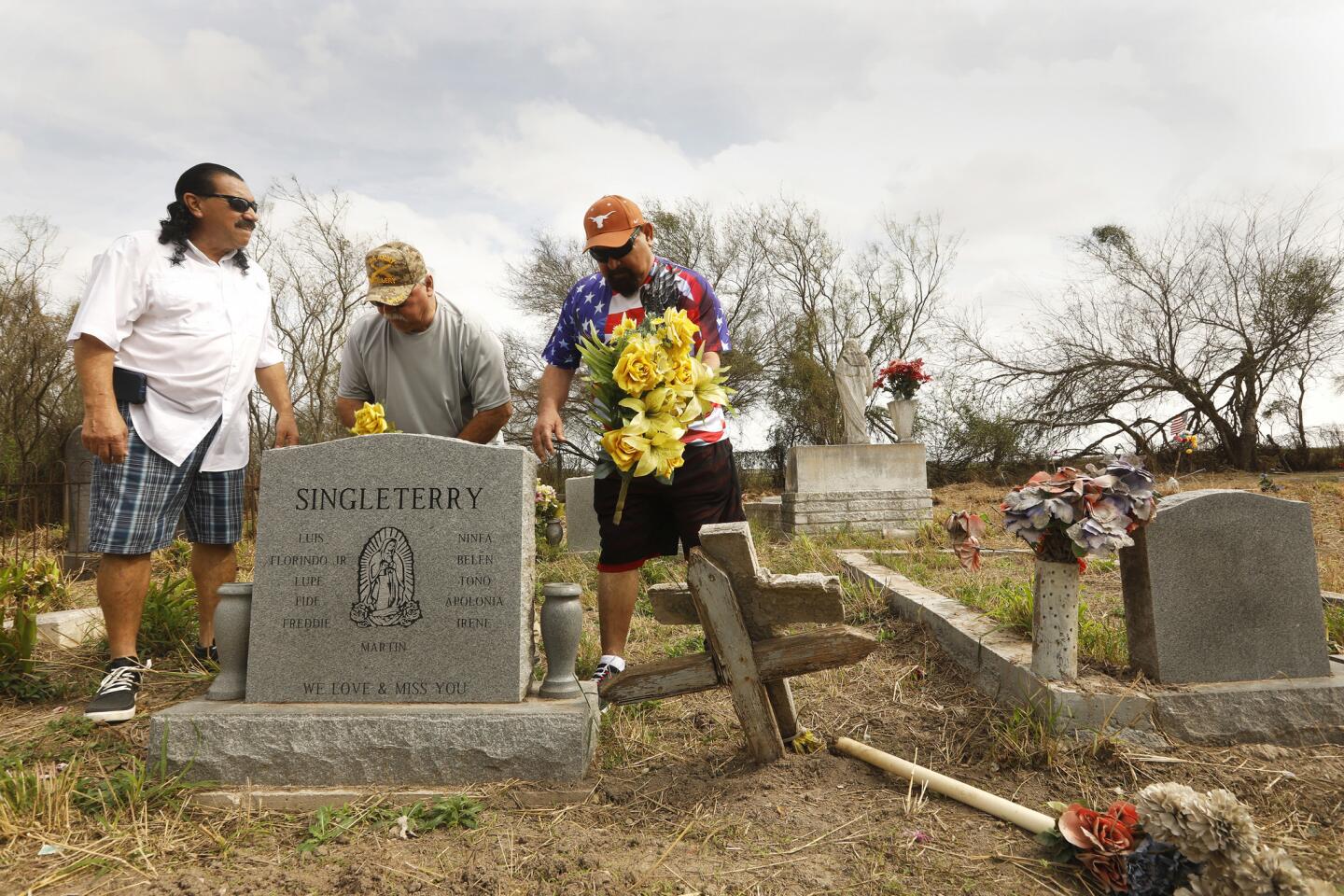Must Reads: Border fence threatens family burial ground — and a slice of African American history

Ramiro Ramirez and his wife, Melinda, discuss the importance of preserving Jackson Ranch Church.
- Share via
Reporting from Pharr, Texas — When Ramiro Ramirez was a boy, his grandmother would bring him to visit the family cemeteries tucked amid vegetable and sugarcane fields here just north of the Rio Grande. He would carry a small bucket of water to help her plant red roses next to the wooden cross marking the grave of his great-great-grandfather, Nathaniel Jackson, who died in 1865.
Growing up, he heard rumors about his father’s black roots and how they almost foiled his parents’ marriage. But only last year — after being contacted by a historian studying the area’s role in the Civil War — did he learn the full truth about his ancestors and their involvement in the Underground Railroad.
“They kept it a secret,” said Ramirez, now 70. “They didn’t pass it on to us.”
Now that history might offer the best hope for saving the family burial grounds.
Last year, the Trump administration started preparations to build a border fence through the cemeteries. Homeland Security Department officials waived laws designed to protect sacred sites, flouting the age-old prohibition against disturbing the dead. Contractors arrived this month in the nearby woods with brush-clearing equipment.
Ramirez and his family have joined forces with local activists to oppose the project, as federal officials send mixed signals about how it will proceed. The plan calls for the fence to be built along a levee that sits about a mile north of the meandering river that divides the U.S. and Mexico, cutting off parts of the cemeteries.
Ramirez and his relatives are worried: How will their children visit them behind a fence? Will their forebears be exhumed? If so, where will they be moved?
The family is also concerned about losing a piece of American history. The Texas Republic wasn’t just shaped by Stephen Austin and Sam Houston — both slave owners — but by Jacksons.
Nathaniel Jackson was born in 1798, the scion of an Alabama plantation family.
He fell in love with a slave named Matilda Hicks; they married and started a family. But with the Civil War brewing, threats mounted against the couple and their children.
New laws empowered slave catchers to round up even slaves who had been freed. So Jackson and his family abandoned the Deep South for Texas, stopping their covered wagons at the Rio Grande, where they could easily flee to Mexico, which had abolished slavery.
Jackson bought a ranch and turned it into a stop on the southern branch of the Underground Railroad, helping slaves on the run. He was never caught.
When he died, he was buried in a family plot. His son Eli was laid to rest nearby in 1911. Two years later, Jackson’s younger son Martin was buried down the road, spawning a second cemetery, Jackson Ranch. Successive generations maintained the cemeteries’ chicken-wire fences, trimmed encroaching briars and protected monuments to descendants who served in World War I, World War II and Korea.
The South was still segregated, and some Tejano families who suspected the Jacksons’ black ancestry balked at allowing their daughters to marry into the family. Over time, suspicions faded.
Jacksons married and became Longorias and Ramirezes. Census rolls no longer listed them as mulatto but as white. Ramiro Ramirez and his siblings tended the Jackson Ranch cemetery over the decades, erecting a cross fashioned from mesquite, mowing the grass and restoring the one-room Methodist chapel that was built in 1874.
In 2012, unaware of their kin’s involvement in the Underground Railroad, family members allowed the Daughters of the Confederacy to place a headstone at one of the cemeteries to honor an ancestor who fought for the South in the Civil War.
Since learning about plans for the border fence, Jackson descendants have been unearthing their history, meeting to share faded black-and-white photographs and other records as they fight the government to save the cemeteries.
Some even contacted a genealogy service to have their DNA tested. Ramirez’s wife’s results came back first. It turned out the blond, blue-eyed Dallas native who married into the family also has black ancestors.
“Some of the sisters and brothers don’t want to hear that part of the story,” Melinda Ramirez said. “Too bad. It’s the truth. Most people in his family know and are fascinated by it.”
Another descendant came to photograph the cemeteries last week for what she feared was the last time. Middle-aged brothers, truck drivers, appeared one morning to walk with protesters past uneven rows of gravestones, pointing out photographs embossed on the stones and retracing the family tree. A retired state trooper came at dusk to smoke cigars and reminisce about the World War II veteran who was unable to marry his sweetheart because of her family’s doubts and died a bachelor.
Even 67-year-old Noemi Jackson, a President Trump supporter, wants the fence rerouted away from the cemeteries.
“I believe in the wall,” she said. “I just don’t like it on our land.”
Last fall, the family found an attorney, who sent the Border Patrol a letter insisting construction shouldn’t start until experts analyze its effects on the cemeteries. Instead, Border Patrol officials waived laws designed to protect historic sites, citing the immediate need to protect the border, and moved ahead with brush clearing.

The attorney, Patrick Reznik, argues that any damage to the cemetery would hurt the region because of its historic value.
This month, the local Carrizo Comecrudo tribe drew volunteers from across the country to occupy the cemeteries, which they say sit on sacred native lands. Ramirez and his relatives gave the group permission to stay and donated water and other supplies.
On Thursday, Ramirez and his family met with staff members of several Texas congressmen, one of whom is married to a Jackson descendant. The staffers told them that Congress hadn’t yet set aside money to build the fence.
Ramiro Ramirez’s 67-year-old sister, Sylvia, said she left the meeting thinking, “OK, we have a little breathing room.”
The next day, Trump signed a spending bill that includes $1.375 billion for about 55 miles of fencing in the Rio Grande Valley and declared a national emergency to fund what he has long promised will be a wall along most of the southern border.
Congress included a provision in the spending bill to ensure that a border fence does not cut off parks and a historic church — but not the cemeteries.
“We’re back to square one worrying again,” Sylvia Ramirez said.
Jason Montemayor, a supervisor on the Border Patrol’s “wall team” in the Rio Grande Valley, didn’t offer the family much comfort when he told a local television station last week that no construction was planned on the border fence near the cemeteries “at this time.”
In an interview with The Times, he said that if a fence is constructed near the cemeteries, the Border Patrol has no intention of exhuming bodies and would “purposely avoid” the Jackson sites.
The agency has asked a local historian to map cemeteries so fence builders can avoid them. If a fence is built north of the Jackson cemeteries, Montemayor said, the family would be given an access code to a gate.
“We will maintain access,” he said.
That’s not what happened during the last major fence-building project by the Border Patrol in the Rio Grande Valley. Following the Secure Fence Act of 2006, at least one family cemetery was bulldozed to make way for a fence near Brownsville, a witness said.
The man, who asked not to be named because he works in the area and wasn’t authorized to speak publicly, said he alerted federal contractors about the presence of grave sites only to see them plowed over in 2009. He said a contractor told him the cemetery wasn’t on his map. A Border Patrol spokesman said the agency had no record of such an incident.
Today, there’s no sign of the cemetery.
The same border fence also cut off other local cemeteries from visitors. Fence entrances near the cemeteries are marked with yellow signs saying, “U.S. government property no trespassing.” Neighbors said Border Patrol agents locked gates or warned visitors not to enter.

Esmeralda Granado, 69, said for years her family used to gather at the cemetery near her home in Brownsville each Easter to picnic and clean relatives’ graves. After the fence went up in 2009, that changed. She and her husband said Border Patrol agents told them crossing any openings in the fence was forbidden.
Last week, after The Times asked the Border Patrol for access, the Granados were allowed to visit the cemetery for the first time in a decade. Unlike a cemetery just north of the fence, it was overgrown with brush, and they were unable to find the white wood crosses that once marked the graves of Juan Granado’s two older brothers. They wished it could have been preserved.
“They were not allowing us,” his wife said. “That’s why it’s abandoned.”
Sylvia Ramirez fears her family’s cemeteries could meet the same fate.
On Wednesday, she and relatives plan to attend a local screening of “Just a Ferry Ride to Freedom,” a documentary about the role of their family and others in the Underground Railroad. Already, so much of their past has been lost as memories fade. If the Jackson cemeteries and their history are to be saved from the government fence, Ramirez said, “I want it in writing. And I want them to say in the future we’re not going to be affected.”
“Until I see those two things,” she said, “I’m not going to let up.”
molly.hennessy-fiske@latimes.com
More to Read
Sign up for Essential California
The most important California stories and recommendations in your inbox every morning.
You may occasionally receive promotional content from the Los Angeles Times.
























